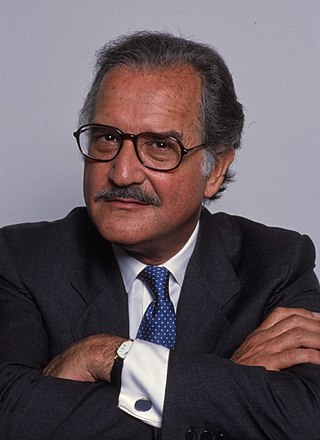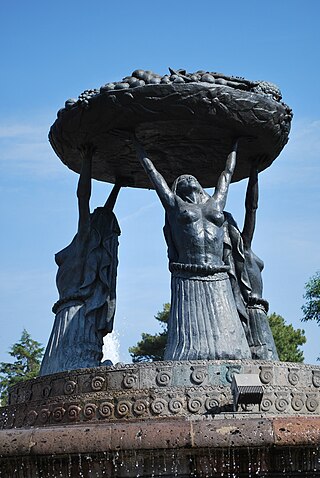
Carlos Fuentes Macías was a Mexican novelist and essayist. Among his works are The Death of Artemio Cruz (1962), Aura (1962), Terra Nostra (1975), The Old Gringo (1985) and Christopher Unborn (1987). In his obituary, The New York Times described Fuentes as "one of the most admired writers in the Spanish-speaking world" and an important influence on the Latin American Boom, the "explosion of Latin American literature in the 1960s and '70s", while The Guardian called him "Mexico's most celebrated novelist". His many literary honors include the Miguel de Cervantes Prize as well as Mexico's highest award, the Belisario Domínguez Medal of Honor (1999). He was often named as a likely candidate for the Nobel Prize in Literature, though he never won.

Alameda Central is a public urban park in downtown Mexico City. Established in 1592, Alameda Central is the oldest public park in the Americas. Located in Delegación Cuauhtémoc between Juárez Avenue and Hidalgo Avenue, the park is adjacent to the Palacio de Bellas Artes and can be accessed by Metro Bellas Artes.
NellieFrancisca Ernestina Campobello Luna was a Mexican writer, notable for having written one of the few chronicles of the Mexican Revolution from a woman's perspective: Cartucho, which chronicles her experience as a young girl in Northern Mexico at the height of the struggle between forces loyal to Pancho Villa and those who followed Venustiano Carranza. She moved to Mexico City in 1923, where she spent the rest of her life and associated with many of the most famous Mexican intellectuals and artists of the epoch. Like her half-sister Gloria, a well-known ballet dancer, she was also known as a dancer and choreographer. She was the director of the Mexican National School of Dance.

The Fountain of Cybele in Mexico City is a bronze statue installed in Colonia Roma in 1980, and refurbished in 2011. A symbol of brotherhood between the Spanish and Mexican communities, it is a replica of the fountain located in the Plaza de Cibeles in Madrid that was built by architect Ventura Rodríguez between 1777 and 1792. The Mexican version is located at a traffic circle in Plaza Villa de Madrid, where Oaxaca, Durango, Medellín and El Oro streets converge in Colonia Roma. The plaza and statue are considered emblematic sights of Mexico City.

The 2011 Pan American Race Walking Cup was held in Envigado, Antioquia, Colombia on 26–27 March. The track of the Cup runs in the Avenida Las Vegas, Barrio Primavera.

Ecatepec, officially Ecatepec de Morelos, is a municipality in the State of Mexico, and is situated in the north part of the Greater Mexico City urban area. The municipal seat is San Cristóbal Ecatepec.

En tierras salvajes is a Mexican telenovela that aired on Las Estrellas from 31 July 2017 to 5 November 2017. The series is produced by Salvador Mejía for Televisa. It is an original story created by Ramón Campos and Gema R. Neira, and stars Claudia Álvarez, Diego Olivera, Cristián de la Fuente, Horacio Pancheri, Ninel Conde, César Évora and Daniela Romo.

The Fountain of Neptune is installed in Mexico City's Alameda Central, in Mexico. The fountain has a bronze sculpture depicting Neptune, the Roman God of the sea.

The fountain of Venus is installed in Mexico City's Alameda Central, in Mexico.

The Fountain of Mercury is installed in Mexico City's Alameda Central, in Mexico. The fountain's statue depicts Mercury.

Las Danaides is a fountain and sculpture in Mexico City's Alameda Central, in Mexico. The statue depicts two women representing the 50 daughters of Danaus (Danaïdes).

País de volcanes is an outdoor fountain and sculpture by the Spanish-born Mexican artist Vicente Rojo Almazán, installed outside Mexico City's Secretariat of Foreign Affairs Building and next to the Memory and Tolerance Museum, in Mexico. It is a 1,000 square meters (11,000 sq ft) artwork that features 1,034 ocher-colored pyramids standing out of the water; the artwork was made with tezontle, a type of reddish volcanic rock. The central body of the fountain contains water that flows subtly down its sides to the area with the pyramids. For Jaime Moreno Villarreal of Letras Libres, the fountain is located slightly below the square level so that the viewer can appreciate the volcanic geography.

The Sierra del Ajusco-Chichinauhtzin, also known as Serranía del Ajusco or Sierra de Chichinauhtzin, is a Mexican mountain range located between Mexico City and the states of Morelos and Mexico. It makes up the southern part of the mountain necklace that surrounds Mexico City. It is made up of more than one hundred volcanic cones, among which are: Tláloc, Chichinauhtzin (3,430 metres, Xitle (3,100 metres, Cerro Pelado (3,600 metres and Cuauhtzin (3,510 metres. Its maximum height is at the Cruz del Marqués peak on the Ajusco volcano.

Cecilia Suárez is a Mexican actress. She has starred in over 60 films and television shows since 1997, being nominated for her acting on 15 occasions. She has received two lifetime achievement awards for her film and TV career: one in Mexico and one in Spain; in Mexico she was the first woman to receive such an award.

The Rotunda by the Sea is an art installation by sculptor Alejandro Colunga along Puerto Vallarta's Malecón, in the Mexican state of Jalisco. Unveiled in 1996, the work has eight bronze thrones arranged in a circle.
An antimonumenta was installed next to the Fuente de las Tarascas, along Francisco I. Madero Avenue in Morelia, Michoacán, on 8 March 2021, the date commemorating International Women's Day, during the annual march of women protesting against gender violence. The sculpture, symbolically named Antimonumenta, was inspired by other similar anti-monuments like the one in Mexico City. The erection of an antimonumenta symbolizes the demand for justice for women who suffer from violence in the country.

The Fuente de las Tarascas, also known as the Fuente de la Fertilidad, is a fountain, sculpture and landmark installed in Morelia, Michoacán, Mexico. The original work was created by Antonio Silva Díaz and Benigno Lara and was installed in 1931 in the intersection of Francisco I. Madero Avenue and Acueducto Avenue, in the historic center of the city. The fountain had three colorful concrete statues that depicted three bare-chested, kneeling women holding a basket of fruits. The sculpture was replaced in 1965 by another work.
Avenida Constituyentes is an avenue in Mexico City that runs from east to west. It is a principal access road to the Santa Fe, Mexico City business district. It is named in honor of the Constitution of Mexico. The avenue serves Álvaro Obregón and Miguel Hidalgo districts.
















